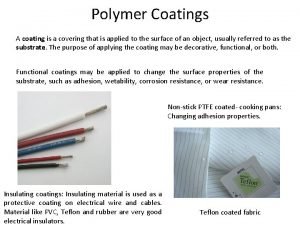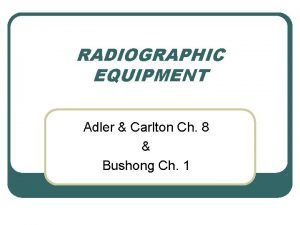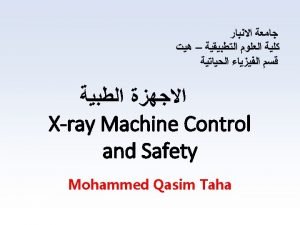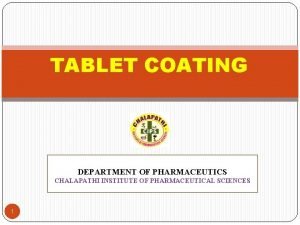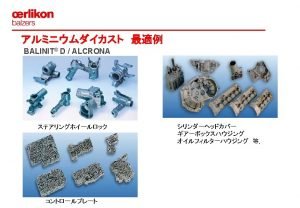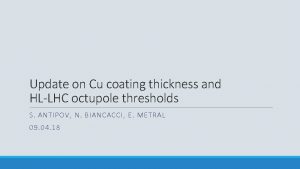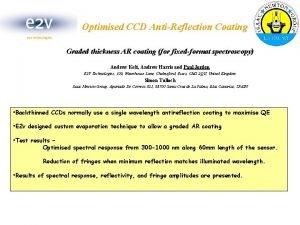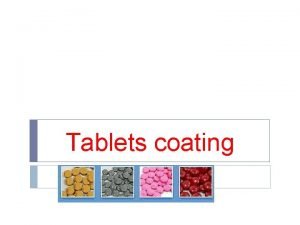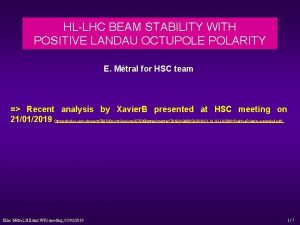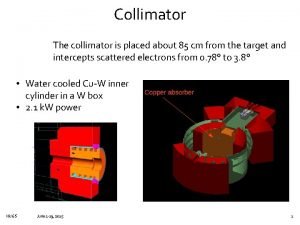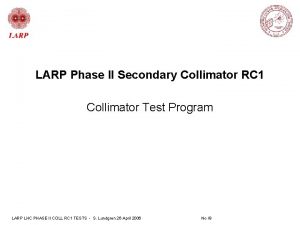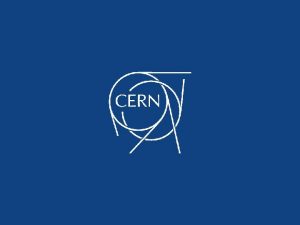Effect of collimator coating thickness on HLLHC octupole









- Slides: 9

Effect of collimator coating thickness on HL-LHC octupole thresholds S. ANTIPOV, N. BIANCACCI 26. 02. 18

Motivation and previous work Operation at the HL-LHC intensity (2. 3 x 1011 ppb) is not compatible with the present LHC transverse impedance In order to reduce the impedance, an upgrade of the collimator system is planned ◦ Lower the total impedance and the octupole threshold by ~ 50% Secondary collimators in IR-7 are coated with 5 μm Mo ◦ The coating thickness should provide sufficient margins for stable operation References: N. Biancacci, ‘Update on the HL-LHC impedance budget’, 4 th HL-LHC Meeting, KEK, Japan, 2014 E. Metral, et al. , ‘Beam intensity limitations’, 4 th HL-LHC Meeting, KEK, Japan, 2014 N. Biancacci, ‘HL-LHC impedance and beam stability’, 5 th HL-LHC Meeting, CERN, 2015 S. Antipov, et al. , ‘Machine impedance and HOM power update’, 7 th HL-LHC Meeting, Madrid, 2017 A. Mereghetti, et al. , ‘Impedance measurement of TCSPM collimator’, LHC MD 2193 Note, CERN, in preparation 9/26/2020 S. ANTIPOV, COLLIMATOR COATING THICKNESS

Goal: Update the estimate on how the thickness of the coating affects the octupole threshold Most challenging, Ultimate, OP scenario Three coating scenarios: ◦ Mo+Mo. Gr ◦ Cu+CFC Various coating thickness: ◦ 1, 3, 5 μm 9/26/2020 Energy, b* E = 7 Te. V, b* = 40 cm Beam intensity M = 2760, Nb = 2. 3 x 1011 p Beam emittance Bunch length en = 2. 1 mm (injection) sz = 9. 0 cm, rms, Gaussian Damper d = 100 turns-1 Octupole SD Negative polarity, no ATS Tails cut at 3 rms beam size Collimator settings Nominal (2. 5 mm ref. e): TCP – 6. 7 s TCSG – 9. 1 s S. ANTIPOV, COLLIMATOR COATING THICKNESS

The bulk has little effect on impedance for a sufficiently thick coating frf Material Bulk resistivity (n. W-m) CFC 5000 Mo. Gr 1000 Cu 26 Mo 53. 5 9/26/2020 S. ANTIPOV, COLLIMATOR COATING THICKNESS

Octupole threshold increases for thinner coatings Mo: +20 A for Q’ ~ 8 -12 Cu: no significant difference for Cu around Q’ ~ 10 The effect may be large at some chromaticities 9/26/2020 S. ANTIPOV, COLLIMATOR COATING THICKNESS

Conclusion The choice of bulk collimator material has little effect on the machine impedance and hence beam stability if the coating is sufficiently thick 5 μm coating provides a significant safety margin in terms of the octupole threshold The increase of octupole current for thinner coatings is relatively small for most positive Q’, even when its thickness is reduced to 1 μm ◦ Up to 20 A (~10% of the total) for Mo coating on Mo. Gr and Q’ ~ 10 ◦ Nearly no effect for better coatings with lower resistivity, such as Cu ◦ The octupole threshold may double for certain values of Q’ 9/26/2020 S. ANTIPOV, COLLIMATOR COATING THICKNESS

Back-up slides 9/26/2020 S. ANTIPOV, COLLIMATOR COATING THICKNESS

Impedance of different coating thickness options frf 9/26/2020 frf S. ANTIPOV, COLLIMATOR COATING THICKNESS frf

Increase in octupole threshold assuming ΔQ’ = ± 1 uncertainty in Q’ 9/26/2020 S. ANTIPOV, COLLIMATOR COATING THICKNESS
